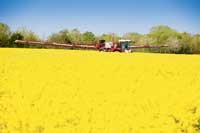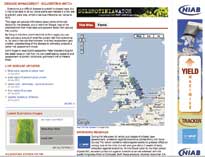Look out for Sclerotinia Watch

Sclerotinia is a difficult disease to manage. In some years when risk appears low such as 2008, it suddenly explodes, while in other years it barely causes a whimper.
It was like that in 2009 when, after two consecutive high pressure years, it came as some surprise that oilseed rape crops had the lowest levels of sclerotinia since 1996.
Levels can only be higher this season, suggests Peter Gladders of ADAS, although accurately forecasting the disease is difficult for researchers, he admits.
“Sclerotinia is an individual field disease,” he says. “It’s not like foliar diseases which spread across farms and regions – only certain fields are affected.”
There is limited spore movement from field to field but a look at the history of the field and the farm, especially in the last two years, will tell growers a great deal about the risk for the season ahead.
“Sclerotinia needs a combination of three factors to cause a problem,” he explains. “The crop has to be at the flowering stage, the weather has to be conducive for germination and infection and there has to be inoculum present.”
It’s the last factor on this list – the level of inoculum present in the field – which is holding up progress with forecasting, reports Dr Gladders.
“It’s very difficult to define inoculum levels. Petal testing can be used to show if they are infected, but not by how much. A new research project is looking to see if DNA testing of flowers or plants could help.”
Without a measurement of inoculum levels, growers must make best use of previous history and seasonal factors when doing an assessment of the disease risk, says Dr Gladders.
“The final consideration is that the fungicides used are only protectant. So they have to be applied at the right time – being just one day late can cause problems.”
Having the right weather to get the spray on is a further issue, he acknowledges. “Early to mid flowering is the critical stage, so growers just using one sclerotinia spray must pay attention to timing. In this situation, forecasting is very important.”
The need for a second spray occurs when sclerotinia has several infection events and flowering is prolonged, he says.
“As a rule of thumb, if growers are expecting 10-20% infection, one spray should be sufficient. But where 40-60% is predicted, growers should spray at early flowering and again three weeks later.”
In a two-spray situation, it is important to check crops two weeks after the first application, notes Dr Gladders. “Don’t wait another week before monitoring – the fungicides fade after three weeks.”
He highlights night temperatures as a good indicator of risk. “If temperatures are below 6C at night, there is not much risk as the sclerotia won’t germinate. But once they reach 7C, the situation changes.”
When the time comes, he suggests that growers look at the weather forecast for the week ahead, paying particular attention to temperature. “If the crop is flowering and night temperatures have reached a minimum of 7C, you should see whether you can get a spray on ahead of any rain.”
Rain aids petal stick, which allows the fungus to infect the plants. “Rain is needed at some stage for the disease to develop, but a dry spring doesn’t stop the disease as it provides good conditions for spore dispersal.”
Despite the absence of the disease last year, treatments were still cost-effective, says Dr Gladders.
“We recorded 0.1-0.2t/ha yield increases from early-mid flowering sprays. There’s a leaf greening benefit, as well as control of any powdery mildew and light leaf spot. So it can be worthwhile, even where the sclerotinia risk is very low.”
How you can get involved
 Accurately forecasting sclerotinia is far from easy, which is why Farmers Weekly has combined with BASF, ADAS and Agrovista to trial a new service, Sclerotinia Watch.
Accurately forecasting sclerotinia is far from easy, which is why Farmers Weekly has combined with BASF, ADAS and Agrovista to trial a new service, Sclerotinia Watch.
The aim is to build a picture of the status of some of the risk factors for sclerotinia across the country, to help give an indication of likely threat from the disease.
That is critical, BASF’s Will Reyer points out. “Sclerotinia is a serious yield robber, which must be anticipated. High infection levels can reduce yields by more than 50% in extreme cases and the emphasis has to be prevention, as once infection occurs it is too late to prevent losses.”
So the initiative asks growers to submit information about growth stage, variety and soil temperature – three factors that will determine disease risk, along with the weather.
Agrovista will also be providing soil temperature, growth stage and variety data from its trials sites around the country to provide regional examples across a range of different varieties.
Soil temperature, in particular, is a factor Dr Gladders wants to assess more closely, so the Sclerotinia Watch data will help provide information about soil temperatures during the critical period to relate back to the overall risk during the season.
Growers can claim a free soil thermometer from BASF to measure the temperature by simply registering to take part in the initiative.
In addition, Dr Gladders will be posting his own petal-testing data on a Sclerotinia Watch blog, along with his own thoughts on disease risk during the critical period.

